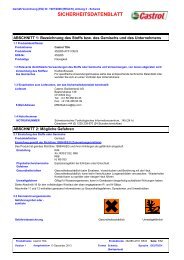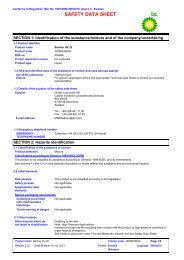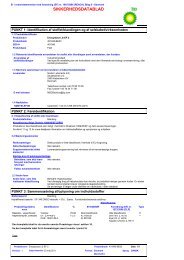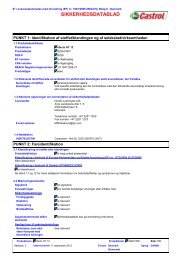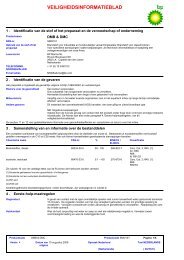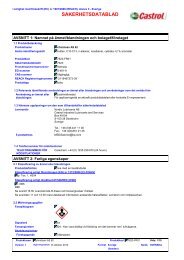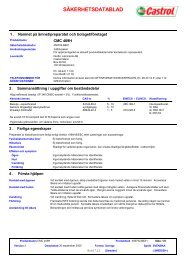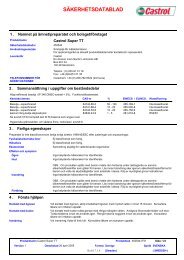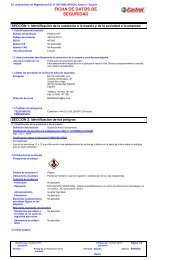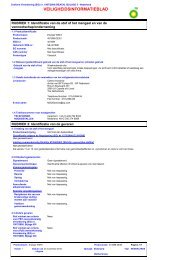2802 Olit 2 EP (English (GB)) BP EU SDS - Lithuania [LT-ILS-Castrol]
2802 Olit 2 EP (English (GB)) BP EU SDS - Lithuania [LT-ILS-Castrol]
2802 Olit 2 EP (English (GB)) BP EU SDS - Lithuania [LT-ILS-Castrol]
You also want an ePaper? Increase the reach of your titles
YUMPU automatically turns print PDFs into web optimized ePapers that Google loves.
SAFETY DATA SHEET<br />
1 . Identification of the substance/preparation and company/undertaking<br />
Product name<br />
<strong>SDS</strong> no.<br />
<strong>Olit</strong> 2 <strong>EP</strong><br />
Product use Lubricant<br />
Supplier<br />
EMERGENCY TEL<strong>EP</strong>HONE<br />
NUMBER<br />
2 .<br />
DE-08150, AT-3105, SL-8150, PL-8150, RU-8150, EE-8150, <strong>LT</strong>-8150, CZ-508150, SK-8150, HU-08150,<br />
BE-461579, NL-461579<br />
Nordic Lubricants A/S <strong>BP</strong> Division<br />
Valguma 5 , LV-1048<br />
Riga,<br />
Latvia<br />
Carechem: +44 (0) 208 762 8322<br />
Composition/information on ingredients<br />
Highly refined mineral oil and additives. Thickening agent.<br />
This product does not contain any hazardous ingredients at or above regulated thresholds.<br />
3 .<br />
Hazards identification<br />
This preparation is not classified as dangerous according to Directive 1999/45/EC as amended and adapted.<br />
Effects and symptoms<br />
Eyes May cause mild eye irritation.<br />
Skin Prolonged or repeated contact can defat the skin and lead to irritation and/or dermatitis.<br />
Inhalation Inhalation of oil mist or vapours at elevated temperatures may cause respiratory irritation.<br />
4 .<br />
Ingestion Ingestion may cause gastrointestinal irritation and diarrhoea.<br />
Eye contact<br />
Skin contact<br />
Inhalation<br />
First-aid measures<br />
In case of contact, immediately flush eyes with a copious amount of water for at least 15 minutes. Get<br />
medical attention if irritation occurs.<br />
Wash skin thoroughly with soap and water or use recognised skin cleanser. Remove contaminated<br />
clothing and shoes. Wash clothing before reuse. Clean shoes thoroughly before reuse. Get medical<br />
attention if irritation develops.<br />
If inhaled, remove to fresh air. Get medical attention if symptoms appear.<br />
Ingestion Do NOT induce vomiting unless directed to do so by medical personnel. Never give anything by mouth to<br />
an unconscious person. If large quantities of this material are swallowed, call a physician immediately.<br />
5 .<br />
Fire-fighting measures<br />
Extinguishing media<br />
Suitable<br />
Not suitable<br />
Hazardous decomposition<br />
products<br />
Special fire-fighting<br />
procedures<br />
Protection of fire-fighters<br />
In case of fire, use water spray (fog), foam, dry chemical or CO2 extinguisher or spray.<br />
Do not use water jet.<br />
These products are carbon oxides (CO, CO2). Some metallic oxides.<br />
Unusual fire/explosion hazards This material is not explosive as defined by established regulatory criteria.<br />
None identified.<br />
Fire-fighters should wear self-contained positive pressure breathing apparatus (SCBA) and full turnout<br />
gear.<br />
Product name <strong>Olit</strong> 2 <strong>EP</strong><br />
Product code<br />
Build 7.2.2<br />
461579-DE03<br />
Version 1 Date of issue 17 November 2005 Format <strong>Lithuania</strong><br />
Language ENGLISH<br />
(<strong>Lithuania</strong>)<br />
Page: 1/4<br />
( ENGLISH )
6 . Accidental release measures<br />
Personal precautions<br />
Environmental precautions<br />
and clean-up methods<br />
Personal protection in case of<br />
a large spill<br />
7 .<br />
Handling<br />
Storage<br />
Handling and storage<br />
Ingredient name<br />
Immediately contact emergency personnel. Keep unnecessary personnel away. Use suitable protective<br />
equipment (See Section: "Exposure controls/personal protection"). Follow all fire fighting procedures (See<br />
Section: "Fire-fighting measures").<br />
If emergency personnel are unavailable, contain spilled material. Use a tool to scoop up solid or absorbed<br />
material and place into appropriate labeled waste container. Minimize contact of spilled material with soils<br />
to prevent runoff to surface waterways. See Section 13 for Waste Disposal Information.<br />
Splash goggles. Full suit. Boots. Gloves. Suggested protective clothing might not be sufficient; consult a<br />
specialist BEFORE handling this product.<br />
Wash thoroughly after handling.<br />
8 . Exposure controls/personal protection<br />
Distillates (petroleum), hydrotreated, heavy<br />
naphthinic (Highly refined mineral oil)<br />
Distillates (petroleum), solvent-refined heavy<br />
paraffinic (Highly refined mineral oil)<br />
Keep container tightly closed. Keep container in a cool, well-ventilated area.<br />
ACGIH (United States).<br />
STEL: 10 mg/m 3 15 minute(s). Form: Oil mist, mineral<br />
TWA: 5 mg/m 3 8 hour(s). Form: Oil mist, mineral<br />
ACGIH (United States).<br />
STEL: 10 mg/m 3 15 minute(s). Form: Oil mist, mineral<br />
TWA: 5 mg/m 3 8 hour(s). Form: Oil mist, mineral<br />
Where there are no regulatory exposure limits, for information and guidance, the ACGIH values are included.<br />
For further information on these please consult your supplier.<br />
Control Measures Provide exhaust ventilation or other engineering controls to keep the airborne concentrations of vapours<br />
below their respective occupational exposure limits.<br />
Hygiene measures Wash hands, forearms and face thoroughly after handling chemical products, before eating, smoking<br />
and using the lavatory and at the end of the working period.<br />
Personal protective equipment<br />
Respiratory system<br />
Occupational exposure limits<br />
None required; however, use of adequate ventilation is good industrial practice.<br />
Skin and body Wear appropriate clothing to avoid prolonged skin contact.<br />
Hands Wear protective gloves if prolonged or repeated contact is likely.<br />
Chemical resistant gloves. Recommended: nitrile gloves<br />
The correct choice of protective gloves depends upon the chemicals being handled, the conditions of<br />
work and use, and the condition of the gloves (even the best chemically resistant glove will break down<br />
after repeated chemical exposures). Most gloves provide only a short time of protection before they<br />
must be discarded and replaced. Because specific work environments and material handling practices<br />
vary, safety procedures should be developed for each intended application. Gloves should therefore be<br />
chosen in consultation with the supplier/manufacturer and with a full assessment of the working<br />
conditions.<br />
Eyes Safety glasses with side shields.<br />
9 .<br />
Physical and chemical properties<br />
Colour Yellow.<br />
Odour Slight.<br />
Physical state Solid. (Paste.)<br />
11 . Toxicological information<br />
Chronic toxicity<br />
12 .<br />
Carcinogenic effects No component of this product at levels greater than 0.1% is identified as a carcinogen by ACGIH, the<br />
International Agency for Research on Cancer (IARC) or the European Commission (EC).<br />
Ecological information<br />
Persistence/degradability<br />
Inherently biodegradable.<br />
Mobility Nonvolatile. Paste. Insoluble in water.<br />
Environmental hazards Not classified as dangerous.<br />
13 .<br />
Disposal considerations<br />
Disposal Consideration /<br />
Waste information<br />
14 . Transport information<br />
Avoid contact of spilled material and runoff with soil and surface waterways. Consult an environmental<br />
professional to determine if local, regional or national regulations would classify spilled or contaminated<br />
materials as hazardous waste. Use only approved transporters, recyclers, treatment, storage or disposal<br />
facilities. Dispose of in accordance with all applicable local and national regulations.<br />
Not classified as hazardous for transport (ADR/RID, ADNR, IMDG, ICAO/IATA)<br />
15 .<br />
Regulatory information<br />
Label requirements<br />
Risk phrases<br />
This product is not classified according to the <strong>EU</strong> regulations.<br />
<strong>EU</strong> regulations Classification and labelling have been performed according to <strong>EU</strong> directives 1999/45/EC and<br />
67/548/EEC as amended and adapted.<br />
Other regulations<br />
16 .<br />
History<br />
Inventories<br />
Other information<br />
Date of issue 17/11/2005.<br />
Date of previous issue<br />
AUSTRALIAN INVENTORY (AICS): Not determined.<br />
CANADA INVENTORY (DSL): Not determined.<br />
CHINA INVENTORY (IECS): Not listed.<br />
EC INVENTORY (EINECS/ELINCS): In compliance.<br />
JAPAN INVENTORY (ENCS): Not listed.<br />
KOREA INVENTORY (ECL): Not listed.<br />
PHILIPPINE INVENTORY (PICCS): Not listed.<br />
US INVENTORY (TSCA): In compliance.<br />
No Previous Validation.<br />
Prepared by Product Stewardship<br />
Notice to reader<br />
All reasonably practicable steps have been taken to ensure this data sheet and the health, safety and environmental information contained in it is<br />
accurate as of the date specified below. No warranty or representation, express or implied is made as to the accuracy or completeness of the<br />
data and information in this data sheet.<br />
The data and advice given apply when the product is sold for the stated application or applications. You should not use the product other than for<br />
the stated application or applications without seeking advice from us.<br />
It is the user’s obligation to evaluate and use this product safely and to comply with al applicable laws and regulations. The <strong>BP</strong> Group shal not<br />
be responsible for any damage or injury resulting from use, other than the stated product use of the material, from any failure to adhere to<br />
recommendations, or from any hazards inherent in the nature of the material. Purchasers of the product for supply to a third party for use at work,<br />
Product name <strong>Olit</strong> 2 <strong>EP</strong><br />
Product code<br />
Build 7.2.2<br />
461579-DE03<br />
Version 1 Date of issue 17 November 2005 Format <strong>Lithuania</strong><br />
Language ENGLISH<br />
(<strong>Lithuania</strong>)<br />
Page: 3/4<br />
( ENGLISH )
have a duty to take all necessary steps to ensure that any person handling or using the product is provided with the information in this sheet.<br />
Employers have a duty to tell employees and others who may be affected of any hazards described in this sheet and of any precautions that<br />
should be taken.<br />
Product name <strong>Olit</strong> 2 <strong>EP</strong><br />
Product code<br />
Build 7.2.2<br />
461579-DE03<br />
Version 1 Date of issue 17 November 2005 Format <strong>Lithuania</strong><br />
Language ENGLISH<br />
(<strong>Lithuania</strong>)<br />
Page: 4/4<br />
( ENGLISH )


![2802 Olit 2 EP (English (GB)) BP EU SDS - Lithuania [LT-ILS-Castrol]](https://img.yumpu.com/12015961/1/500x640/2802-olit-2-ep-english-gb-bp-eu-sds-lithuania-lt-ils-castrol.jpg)
